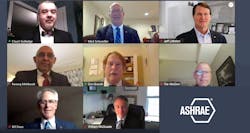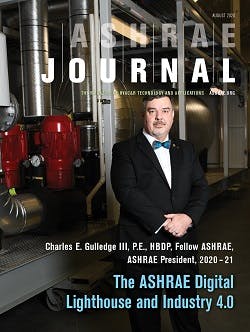Calling Chuck Gulledge’s first months atop the American Society of Heating, Refrigerating and Air-conditioning Engineers (ASHRAE) a “baptism of fire” may sound dramatic, but the ongoing pandemic forced everything online and even delayed opening of the group’s new HQ. But there have been unexpected pluses, too.
++++++++++
By ROB McMANAMY, with TERENCE McIVER
Special to HPAC Engineering and Contracting Business
When new ASHRAE President Charles E. Gulledge III, P.E., HBDP, and ASHRAE Fellow, gave his inaugural address online this summer, his theme of remote collaboration seemed so current that few could have imagined he had actually started writing it a year earlier. But 2020 has upended all of our imaginations, it seems. And while the COVID-19 pandemic’s stark human and economic toll has been mammoth worlwide, it has also created conditions and opportunities that have accelerated some initiatives beyond what would have been forecast.
“The pandemic narrative is causing so much pain, and opportunity. It is forcing our industry to survive in ways it could not have imagined,” Gulledge told us via Uberconference earlier this fall. “We are doing everything online now, collaborating in the cloud, and not skipping a beat.”
Specific to the pandemic, itself, ASHRAE’s Epidemic Task Force also has assumed a crucial role this year, issuing updated health and safety guidelines and recommendations throughout the summer, helping schools, businesses, and the general public to navigate the anxious months that have altered all of our lives. (Of note, the task force is chaired by HPAC Engineering advisory board member Bill Bahnfleth, Ph.D., P.E.)
“I’ve been very proud of them,” said Gulledge. “It’s really been one of the better, speed-to-business, outreach efforts in ASHRAE’s history.”
Outreach, both across the U.S. and internationally, also has been a surprising success so far, thanks to technology. “By eliminating travel and all the time that requires, I was actually able to visit 40 ASHRAE chapters in my first two months,” he acknowledged. “I was just speaking with one of our chapters in Pakistan this morning,” he added.
Leaning Into Digital
While its method of delivery has changed, the core of Gulledge’s message this year has not. As the 2020- 2021 president of the American Society of Heating, Refrigerating and Air-Conditioning Engineers, he had always intended to promote Lean Integrated Project Delivery from his new pulpit. LIPD “combines Lean management principles with a collaborative, aligned team and contract structure to improve the outcomes of construction projects.”
The LIPD method is not yet a reality for many mechanical systems firms, but recent trends and wake-up calls — including COVID-19 — are serving as market disruptors, to a point where many more HVAC contractors will find it essential that they begin operating in the Lean world.
During his inaugural presidential address online to the ASHRAE Virtual Summit in June, Gulledge described the integrated framework for The ASHRAE Digital Lighthouse and Industry 4.0, an ambitious outline of those project philosophies methods and digital transformations he believes must become standards for the HVACR mechanical systems industry, and construction generally.
Gulledge’s theme going into 2021, is the need to focus on “reimagining” the building industry, and the Society’s place within that industry, by further integrating HVACR segments into Lean Construction, and by adopting the leading digital technology.
During his ASHRAE address, Gulledge used analogies gleaned from his childhood experience on his grandparents’ potato farm in Valdese, NC, to describe how proven and essential farming processes (plowing, planting, maintaining, harvesting) can be applied to engineering and construction. And now, he wants to plant seeds of digital innovation at ASHRAE that he hopes will take root across the built environment.
Gulledge’s speech reviewed the six principles of lean collaboration:
- Respect for people;
- Optimize the whole;
- Generate value;
- Eliminate waste;
- Focus on flow;
- Continuous improvement.
Introduced to the ‘Big Room’
Gulledge’s activity in the Lean world began about 16 years ago, when he started as a design/build engineer, which brought him into contact with Fortune 100 level companies that were striving to improve how their projects were delivered. “They were tired of solutions that didn’t work, having all this waste, and not having any value discovered for them,” he recalled. His first exposure to true Lean IPD and a collaborative “Big Room” showed him how people could work together collaboratively from the very beginning of a project, to craft the best methods for delivering a built solution.
“That’s when I discovered what the Lean Construction Institute (LCI) was preaching, and I just fell in love with it,” he said. “I immediately bought all of their books, so I could read about things like targeted value design, Lean, and Lean IPD.”
Fast forward to the present-day background of the COVID-19 pandemic —which Gulledge acknowledged has caused and continues to cause pain for many —digital collaboration has been a true blessing, helping teams to stay on track with project collaboration.
“It’s no different than having a colleague on the other side of the door to collaborate with,” he said, by using Teams, Zoom, Go-To Webinars and other discussion platforms. And interestingly, Gulledge conceded how, over time, his inaugural address had evolved to become a surprisingly prophetic message.
“People are discovering, ‘Wow, look at what we can do when forced to work this way.’ I think it’s forcing people to realize how things can be done, and how work can be done in the cloud, and how a singular ‘lighthouse’ mentality can come into play,” he explained. “There’s one storyline now, and we’re all working on it from remote locations, and it’s a beautiful thing to watch.”
As an added incentive to action, Gulledge said the pandemic has prompted stakeholders in government, education, and other public sectors that are so dependent on efficient and safe buildings, to contact ASHRAE in search of solutions. Industry must run, not walk, off of square one, and put action behind the digital tools that are now available.
“Everybody wants to know, ‘How do I reopen my building and make it safe for the occupants that are in that building?’ Here’s an interesting spin I heard from one unnamed source: “How do we communicate that we are taking a good standard of care to protect the people that are within our buildings?” And I felt that was very eloquently phrased.”
So, moving forward, Gulledge emphasized that it will be important for engineers proactively to remind building owners, and in turn, building occupants, that a sufficient standard of care is being taken to ensure occupant safety.
The Persistent Issue of Waste
During his ASHRAE address, Gulledge also noted that our industry is still filled with inefficiencies that result in an annual loss of $177 billion, and — according to a 2017 McKinsey report, and corroborated by both LCI and the U.S. Dept. of Labor — true construction productivity — in new construction, renovation and other building work — has grown by a mere 1% in 20 years. Those inefficiencies include looking for information; engaging in conflict resolution; dealing with mistakes; and performing rework.
During our interview, Gulledge described it as a disconnect, “in how we are delivering solutions, whether they are new Greenfield projects, Brownfield projects, or renovation of existing building stock.” If the process were a painting it would be less Michelangelo and more Jackson Pollock.
“The process has so much waste along the path and is just continually recreating knowledge, reworking stuff, fighting over who has what real estate, fixing stuff that doesn’t work, and tearing out stuff that’s in the way. Basically, the engineering and construction is very nonproductive. That’s because the team changes on every job,” he said. Gulledge believes a vast majority of construction firms have delayed taking a Lean construction path because they are “tethered to the analog age,” and are concerned about risk.
“We protect our silos from the impacts of other people,” he explained. “Contractually, look at how we are engaged on projects all the way through: the owner hires an architect; the architect hires different consultants to help out; projects get put out to bid to multiple contractors; one is selected; and now you’ve got multiple contracts going there. [So] our process is siloed. And what gets lost in that path is the connection of knowledge. We continuously recreate knowledge, having all of these touch points of, ‘Okay, we’ve reached another plateau. Now we have to do this part of the process,’ and it’s just not integrated.”
Gulledge said he is encouraged by the prospect of increasing numbers of Lean Construction disciples, as organizations evolve in a newer world of safety concerns, to say nothing of ongoing building efficiency goals. Exposure to Lean Construction, he continued, is “opening people’s eyes by force, not necessarily by maturation. It’s forcing some people and some organizations to evolve quickly, so that they don’t get left out and shut out from being able to perform work, and deliver projects, whether you’re designing it, building it or selling it.”
ASHRAE too, now settled into a its new headquarters building in Atlanta, is on a digital learning track, which is an essential development, if the Society wishes to be a leading learning resource in the application of advanced digital tools.
“ASHRAE needs to evolve to this digital world also. And I actually have an ad hoc of people working right now on what it is we do, as far as that digital training. We will be providing training, however. I don’t know how we’re going to do that yet, or who is going to do it. [But] this is in demand, and we need to do it.”
Lean, Digital Technologies
The following technologies are among those Gulledge believes are (and will be) essential to the expanding of Lean Construction Integrated Project Delivery in the HVACR environment, or “Industry 4.0”:
- Mobile Devices;
- IoT Platforms;
- Location Detection Technologies;
- Advanced Human-Machine Interfaces;
- Authentication and Fraud Detection;
- 3D Printing;
- Smart Sensors;
- Big Data Analytics and Advanced Algorithms;
- Multilevel Customer Profiling;
- Augmented Reality & Wearables;
- Cloud Computing.
The Digital Toolkit • Virtual Design & Construction • Drones • Light detection & Ranging • Generative design • Digital twins • Common data environments.
As data and analytics become a core capability, related digitization will include:
- Digitization and integration of vertical and horizontal value chains;
- Digitization of product and service offerings;
- Digital business models and customer access.
- Virtual Outreach to Members.
As noted earlier, even though Gulledge’s travel plans were literally grounded by the pandemic, he still had a very productive start to his term as ASHRAE president. Digital technology, itself, kept in him in touch with ASHRAE members all over the world.
“I have already (virtually) visited so many ASHRAE chapters. My capacity to reach the membership has increased like it never would have been possible in the old world of flying around the world and seeing people. To me, that is an interesting development. There is a disappointment factor, of course, of not being able to go and do things. But then I realize what is possible, and what we are accomplishing this year. We are connecting the membership globally because of what we’ve had to do. So that’s another one of those beneficial outcomes of this pivot that’s taking place,” he said.
###########
An earlier version of this interview appears in the October issue of HPAC's sister publication Contracting Business. See that here.
About the Author
Rob McManamy
Editor in Chief
An industry reporter and editor since 1987, McManamy joined HPAC Engineering in September 2017, after three years with BuiltWorlds.com, a Chicago-based media startup focused on tech innovation in the built environment. He has been covering design and construction issues for more than 30 years, having started at Engineering News-Record (ENR) in New York, before becoming its Midwest Bureau Chief in 1990. In 1998, McManamy was named Editor-in-Chief of Design-Build magazine, where he served for four years. He subsequently worked as an editor and freelance writer for Building Design + Construction and Public Works magazines.
A native of Bronx, NY, he is a graduate of both the University of Virginia, and The John Marshall Law School in Chicago.
Contact him at [email protected].


